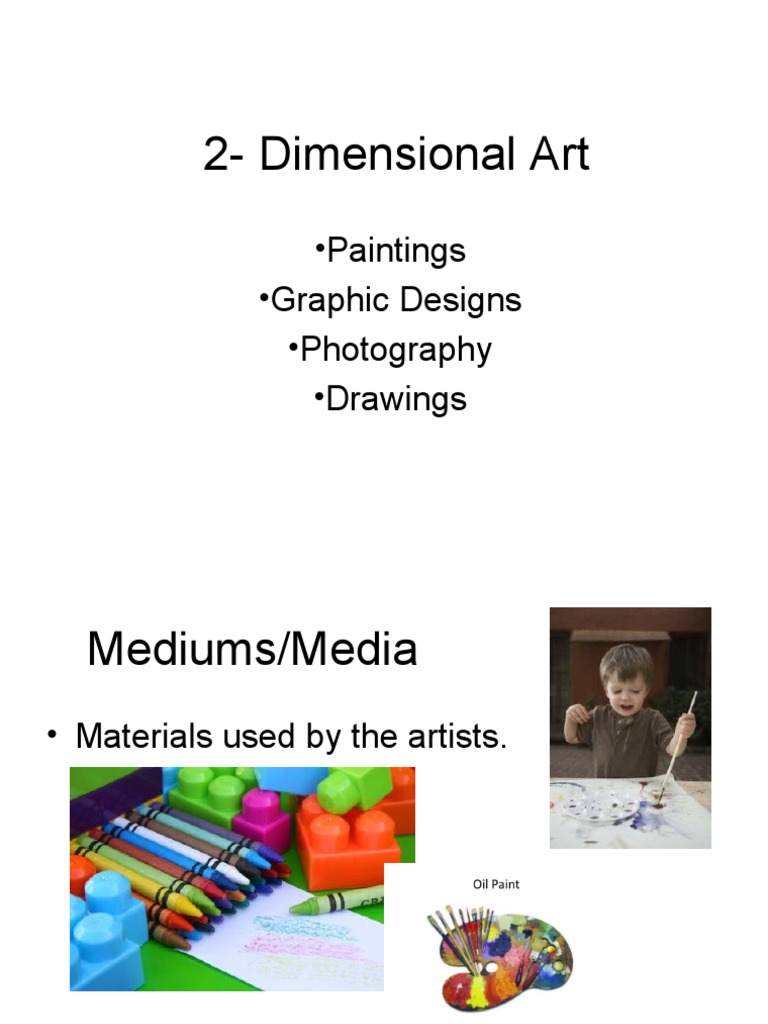2-dimensional art possesses an intrinsic allure that piques the curiosity of enthusiasts and scholars alike. What defines this art form? How is it distinguished from its three-dimensional counterparts? By delving deeper into the characteristics of 2D art, one might unearth a myriad of intricate features that not only define its allure but challenge the boundaries of perception and imagination. This exploration invites contemplation: Can the limitations of a flat medium be transcended to evoke profound emotional and intellectual responses?
At its core, 2-dimensional art is characterized primarily by the employment of height and width, devoid of depth. This fundamental aspect not only serves as a limitation but conversely acts as a canvas for creative expression. Artists often exploit this constraint, transforming flat surfaces into vibrant narratives that resonate with viewers. It is imperative to recognize how this two-dimensionality influences the viewer’s perception, drawing their attention into a world that appears confined yet is rich with possibilities.
Color is one of the most striking features of 2-dimensional art. The manipulation of color can produce diverse emotional responses and lead to heightened viewer engagement. Artists meticulously select color palettes to create harmony, contrast, or even dissonance within their works. The psychological impact of color cannot be overstated; warm hues may evoke feelings of warmth and vitality, while cool tones may impart a sense of tranquility or melancholy. This interplay invites a deeper investigation: How do these color choices correlate to the thematic essence of the artwork?
Furthermore, the application of line presents a pivotal characteristic in 2D art. Lines, whether bold and definitive or soft and insinuating, guide the viewer’s gaze throughout the artwork. They serve not only to delineate forms but also to create rhythm and movement. The varying qualities of lines—straight, curved, thick, and thin—can mirror emotional states or thematic narratives. Consider the implications of a jagged line compared to a fluid curve. Each possesses the power to evoke different feelings and interpretations. Herein lies a challenge for both artists and audiences: Can one truly convey a narrative without the tactile quality inherent to three-dimensional forms?
Texture is yet another vital characteristic that often intrigues viewers. While inherently flat, artists can suggest texture through nuanced techniques such as brushwork, layering, or the use of mixed media. The illusion of texture may entice the viewer to reach out, questioning the very nature of the artwork. This leads to an exploration of tactile perception in 2D works—how can an artist manipulate visual elements to suggest real-world textures? Is there a threshold where visual texture becomes so compelling that it almost invites touch?
Composition, as a strategic arrangement of elements within a piece, plays an essential role in 2-dimensional art. Artists employ compositional strategies to guide the viewer’s eye across the canvas, creating focal points or establishing a narrative flow. Techniques such as the rule of thirds, symmetry, and balance are quintessential. However, the challenge remains: how can one defy traditional compositional guidelines to create innovative and engaging works? The tension created by asymmetrical balance or unexpected placements can radically shift perceptions and provoke thought.
In addition, symbolism permeates the realm of 2-dimensional art, serving as a language unto itself. Artists frequently imbue their works with symbolic meaning, transcending the mere visual to touch upon social, political, and personal themes. This characteristic invites viewers to engage in an interpretive dialogue, heightening their experience and understanding. Here lies an intriguing dilemma: how effective is symbolism in conveying complex ideas when confined to a flat surface? Can a simple image encapsulate a multifaceted narrative, or does it risk oversimplification?
The role of context further enriches the experience of 2-dimensional art. The circumstances surrounding the creation of a work—the artist’s background, socio-political milieu, and historical influences—play a crucial role in its interpretation. A viewer’s understanding of context can dramatically alter their perception of the artwork. This raises questions about the universality of art. In what ways does context constrain or liberate the interpretation of 2-dimensional works? Does a piece communicate differently across cultures and time periods?
Lastly, the evolving nature of technology has profoundly influenced 2-dimensional art. Digital mediums have opened new avenues for artists, allowing them to create works that challenge traditional notions of art. The advent of computer-generated imagery and the proliferation of digital platforms has redefined accessibility and engagement. Yet, with these advancements comes a pressing inquiry: does digital art hold the same intrinsic value as traditional forms? How do the characteristics of digital creations compare to their analog predecessors?
In conclusion, 2-dimensional art encompasses a rich tapestry of characteristics that extend beyond mere aesthetics. It invites reflection on the interplay between limitation and freedom, urging both artists and viewers to engage in a perpetual dialogue. By acknowledging the multifaceted nature of color, line, texture, composition, symbolism, context, and technology, one can cultivate a deeper appreciation for this art form. Ultimately, the challenge lies in the viewer’s ability to transcend the inherent constraints of 2D art, seeking depth and meaning in a realm defined by its flatness. Through this ongoing exploration, the world of 2-dimensional art continues to inspire, provoke, and delight, challenging our perceptions and expanding our understanding of creativity.












